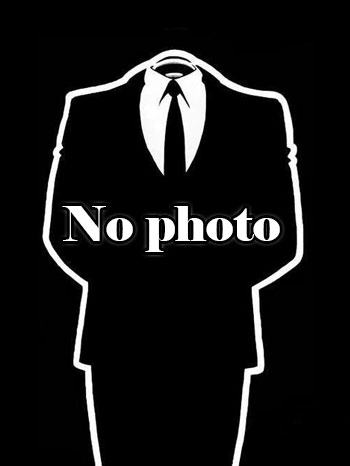Batman

If you like this character, let us know!
Real name Bruce Wayne
Batman is a fictional superhero appearing in American comic books published by DC Comics. The character was created by artist Bob Kane and writer Bill Finger, and first appeared in Detective Comics #27 (May 1939). Originally named "the Bat-Man", the character is also referred to by such epithets as the "Caped Crusader", the "Dark Knight", and the "World's Greatest Detective".
Batman's secret identity is Bruce Wayne, an American billionaire, playboy, philanthropist, and owner of Wayne Enterprises. Having witnessed the murder of his parents as a child, he swore revenge on criminals, an oath tempered with a sense of justice. Wayne trains himself both physically and intellectually and crafts a bat-inspired persona to fight crime. Batman operates in the fictional Gotham City and is assisted by various supporting characters, including his butler Alfred, the police commissioner Jim Gordon, and vigilante allies such as Robin. Unlike most superheroes, Batman does not possess any superpowers; he makes use of his genius intellect, physical prowess, martial arts skills, detective skills, science and technology, vast wealth, provocation of fear and intimidation, and an indomitable will in his continuous war on crime. A large assortment of villains make up Batman's rogues gallery, including his archenemy the Joker.
Batman became popular soon after his introduction and gained his own comic book title, Batman, in 1940. As the decades progressed, differing interpretations of the character emerged. The late 1960s Batman television series used a camp aesthetic which continued to be associated with the character for years after the show ended. Various creators worked to return the character to his dark roots, culminating in 1986 with The Dark Knight Returns by Frank Miller. The success of Warner Bros.' live-action Batman feature films have helped maintain public interest in the character.
An American cultural icon, Batman has been licensed and adapted into a variety of media, from radio to television and film, and appears on a variety of merchandise sold all over the world, such as toys and video games. The character has also intrigued psychiatrists with many trying to understand the character's psyche. In May 2011, Batman placed second on IGN's Top 100 Comic Book Heroes of All Time, after Superman. Empire magazine listed him second in their 50 Greatest Comic Book Characters of All Time. The character has been portrayed on both film and television by Lewis Wilson, Robert Lowery, Adam West, Michael Keaton, Val Kilmer, George Clooney, Christian Bale, David Mazouz, and soon by Ben Affleck.
Biography
Batman's history has undergone various revisions, both minor and major. Few elements of the character's history have remained constant. Scholars William Uricchio and Roberta E. Pearson noted in the early 1990s, "Unlike some fictional characters, the Batman has no primary urtext set in a specific period, but has rather existed in a plethora of equally valid texts constantly appearing over more than five decades."The central fixed event in the Batman stories is the character's origin story. As a little boy, Bruce Wayne is horrified and traumatized to see his parents, the physician Dr. Thomas Wayne and his wife Martha, being murdered by a mugger in front of his very eyes. This drives him to fight crime in Gotham City as Batman. Pearson and Uricchio also noted beyond the origin story and such events as the introduction of Robin, "Until recently, the fixed and accruing and hence, canonized, events have been few in number", a situation altered by an increased effort by later Batman editors such as Dennis O'Neil to ensure consistency and continuity between stories.
Golden Age
In Batman's first appearance in Detective Comics #27, he is already operating as a crime-fighter. Batman's origin is first presented in Detective Comics #33 (November 1939) and is later expanded upon in Batman #47. As these comics state, Bruce Wayne is born to Dr. Thomas Wayne and his wife Martha, two very wealthy and charitable Gotham City socialites. Bruce is brought up in Wayne Manor, and leads a happy and privileged existence until the age of eight, when his parents are killed by a small-time criminal named Joe Chill while on their way home from a movie theater. That night, Bruce Wayne swears an oath to spend his life fighting crime. He engages in intense intellectual and physical training; however, he realizes that these skills alone would not be enough. "Criminals are a superstitious cowardly lot", Wayne remarks, "so my disguise must be able to strike terror into their hearts. I must be a creature of the night, black, terrible..." As if responding to his desires, a bat suddenly flies through the window, inspiring Bruce to take on the persona of Batman.
In early strips, Batman's career as a vigilante earns him the ire of the police. During this period, Bruce Wayne has a fiancée named Julie Madison. In Batman #1 takes in an orphaned circus acrobat, Dick Grayson, who becomes his junior counterpart, Robin. Batman also becomes a founding member of the Justice Society of America, although he, like Superman, is an honorary member, and thus only participates occasionally. Batman's relationship with the law thaws quickly, and he is made an honorary member of Gotham City's police department. During this time, Alfred Pennyworth arrives at Wayne Manor, and after deducing the Dynamic Duo's secret identities, joins their service as their butler.
Silver Age
The Silver Age of Comic Books in DC Comics is sometimes held to have begun in 1956 when the publisher introduced Barry Allen as a new, updated version of The Flash. Batman is not significantly changed by the late 1950s for the continuity which would be later referred to as Earth-One. The lighter tone Batman had taken in the period between the Golden and Silver Ages led to the stories of the late 1950s and early 1960s that often feature many science-fiction elements, and Batman is not significantly updated in the manner of other characters until Detective Comics #327 (May 1964), in which Batman reverts to his detective roots, with most science-fiction elements jettisoned from the series.
After the introduction of DC Comics' multiverse in the 1960s, DC established that stories from the Golden Age star the Earth-Two Batman, a character from a parallel world. This version of Batman partners with and marries the reformed Earth-Two Catwoman, Selina Kyle (as shown in Superman Family #211). They have a daughter, Helena Wayne, who as the Huntress, becomes (along with Dick Grayson, the Earth-Two Robin) Gotham's protector once Wayne retires from the position to become police commissioner, a position he occupies until he is killed during one final adventure as Batman. Batman titles however often ignored that a distinction had been made between the pre-revamp and post-revamp Batmen (since unlike The Flash or Green Lantern, Batman comics had been published without interruption through the 1950s) and would occasionally make reference to stories from the Golden Age. Nevertheless, details of Batman's history were altered or expanded upon through the decades. Additions include meetings with a future Superman during his youth, his upbringing by his uncle Philip Wayne (introduced in Batman #208, January/February 1969) after his parents' death, and appearances of his father and himself as prototypical versions of Batman and Robin, respectively. In 1980 then-editor Paul Levitz commissioned the Untold Legend of the Batman limited series to thoroughly chronicle Batman's origin and history.
Batman meets and regularly works with other heroes during the Silver Age, most notably Superman, whom he began regularly working alongside in a series of team-ups in World's Finest Comics, starting in 1954 and continuing through the series' cancellation in 1986. Batman and Superman are usually depicted as close friends. As a founding member of the Justice League of America, Batman appears in its first story, in 1960's Brave and the Bold #28. In the 1970s and 1980s, Brave and the Bold became a Batman title, in which Batman teams up with a different DC Universe superhero each month.
In 1969, Dick Grayson attends college as part of DC Comics' effort to revise the Batman comics. Additionally, Batman also moves from his mansion, Wayne Manor into a penthouse apartment atop the Wayne Foundation building in downtown Gotham City, in order to be closer to Gotham City's crime. Batman spends the 1970s and early 1980s mainly working solo, with occasional team-ups with Robin and/or Batgirl. Batman's adventures also become somewhat darker and more grim during this period, depicting increasingly violent crimes, including the first appearance (since the early Golden Age) of the Joker as a homicidal psychopath, and the arrival of Ra's al Ghul, a centuries-old terrorist who knows Batman's secret identity. In the 1980s, Dick Grayson becomes Nightwing.
In the final issue of Brave and the Bold in 1983, Batman quits the Justice League and forms a new group called the Outsiders. He serves as the team's leader until Batman and the Outsiders #32 (1986) and the comic subsequently changed its title.
Modern Age
After the 12-issue limited series Crisis on Infinite Earths, DC Comics retconned the histories of some major characters in an attempt at updating them for contemporary audiences. Frank Miller retold Batman's origin in the storyline "Year One" from Batman #404–407, which emphasizes a grittier tone in the character. Though the Earth-Two Batman is erased from history, many stories of Batman's Silver Age/Earth-One career (along with an amount of Golden Age ones) remain canonical in the post-Crisis universe, with his origins remaining the same in essence, despite alteration. For example, Gotham's police are mostly corrupt, setting up further need for Batman's existence. The guardian Phillip Wayne is removed leaving young Bruce to be raised by Alfred Pennyworth. Additionally, Batman is no longer a founding member of the Justice League of America, although he becomes leader for a short time of a new incarnation of the team launched in 1987. To help fill in the revised backstory for Batman following Crisis, DC launched a new Batman title called Legends of the Dark Knight in 1989 and has published various miniseries and one-shot stories since then that largely take place during the "Year One" period.
Subsequently, Batman begins exhibiting an excessive, reckless approach to his crime-fighting, a result of the pain of losing Jason Todd. Batman works solo until the decade's close, when Tim Drake becomes the new Robin.
Many of the major Batman storylines since the 1990s have been inter-title crossovers that run for a number of issues. In 1993, DC published "Knightfall". During the storyline's first phase, the new villain Bane paralyzes Batman, leading Wayne to ask Azrael to take on the role. After the end of "Knightfall", the storylines split in two directions, following both the Azrael-Batman's adventures, and Bruce Wayne's quest to become Batman once more. The story arcs realign in "KnightsEnd", as Azrael becomes increasingly violent and is defeated by a healed Bruce Wayne. Wayne hands the Batman mantle to Dick Grayson (then Nightwing) for an interim period, while Wayne trains for a return to the role.
The 1994 company-wide crossover storyline "Zero Hour" changes aspects of DC continuity again, including those of Batman. Noteworthy among these changes is that the general populace and the criminal element now considers Batman an urban legend rather than a known force.
Batman once again becomes a member of the Justice League during Grant Morrison's 1996 relaunch of the series, titled JLA. During this time, Gotham City faces catastrophe in the decade's closing crossover arc. In 1998's "Cataclysm" storyline, Gotham City is devastated by an earthquake and ultimately cut off from the United States. Deprived of many of his technological resources, Batman fights to reclaim the city from legions of gangs during 1999's "No Man's Land".
Meanwhile, Batman's relationship with the Gotham City Police Department changed for the worse with the events of "Batman: Officer Down" and "Batman: War Games/War Crimes"; Batman's long-time law enforcement allies Commissioner Gordon and Harvey Bullock are forced out of the police department in "Officer Down", while "War Games" and "War Crimes" saw Batman become a wanted fugitive after a contingency plan of his to neutralize Gotham City's criminal underworld is accidentally triggered, resulting in a massive gang war that ends with the sadistic Black Mask the undisputed ruler of the city's criminal gangs. Lex Luthor arranges for the murder of Batman's on-again, off-again love interest Vesper (introduced in the mid-1990s) during the "Bruce Wayne: Murderer?" and "Bruce Wayne: Fugitive" story arcs. Though Batman is able to clear his name, he loses another ally in the form of his new bodyguard Sasha, who is recruited into the organization known as "Checkmate" while stuck in prison due to her refusal to turn state's evidence against her employer. While he was unable to prove that Luthor was behind the murder of Vesper, Batman does get his revenge with help from Talia al Ghul in Superman/Batman #1–6.
DC's 2005 limited series Identity Crisis reveals that JLA member Zatanna had altered Batman's memories to prevent him from stopping the League from lobotomizing Dr. Light after he sexually assaulted Sue Dibny. Batman later creates the Brother I satellite surveillance system to watch over and if necessary, kill the other heroes. The revelation of Batman's creation and his tacit responsibility for Blue Beetle's death becomes a driving force in the lead-up to the Infinite Crisis miniseries, which again restructures DC continuity. Batman and a team of superheroes destroy Brother Eye and the OMACs, though at the very end Batman reaches his apparent breaking point when Alexander Luthor Jr. seriously wounds Nightwing. Picking up a gun, Batman nearly shoots Luthor in order to avenge his former sidekick, until Wonder Woman convinces him to not pull the trigger.
Following Infinite Crisis, Bruce Wayne, Dick Grayson (having recovered from his wounds), and Tim Drake retrace the steps Bruce had taken when he originally left Gotham City, to "rebuild Batman". In the Face the Face storyline, Batman and Robin return to Gotham City after their year-long absence. Part of this absence is captured during Week 30 of the 52 series, which shows Batman fighting his inner demons. Later on in 52, Batman is shown undergoing an intense meditation ritual in Nanda Parbat. This becomes an important part of the regular Batman title, which reveals that Batman is reborn as a more effective crime fighter while undergoing this ritual, having "hunted down and ate" the last traces of fear in his mind. At the end of the "Face the Face" story arc, Bruce officially adopts Tim (who had lost both of his parents at various points in the character's history) as his son. The follow-up story arc in Batman, Batman and Son, introduces Damian Wayne, who is Batman's son with Talia al Ghul. Although originally in Son of the Demon, Bruce's coupling with Talia was implied to be consensual, this arc ret-conned it into Talia forcing herself on Bruce.
Batman, along with Superman and Wonder Woman, reforms the Justice League in the new Justice League of America series, and is leading the newest incarnation of the Outsiders.
Grant Morrison's 2008 storyline, "Batman R.I.P." featured Batman being physically and mentally broken by the enigmatic villain Doctor Hurt and attracted news coverage in advance of its highly promoted conclusion, which would speculated to feature the death of Bruce Wayne. However, though Batman is shown to possibly perish at the end of the arc, the two-issue arc "Last Rites", which leads into the crossover storylines "Final Crisis", shows that Batman survives his helicopter crash into the Gotham City River and returns to the Batcave, only to be summoned to the Hall of Justice by the JLA to help investigate the New God Orion's death. The story ends with Batman retrieving the god-killing bullet used to kill Orion, setting up its use in "Final Crisis". In the pages of Final Crisis Batman is reduced to a charred skeleton. In Final Crisis #7 Wayne is shown witnessing the passing of the first man, Anthro. Wayne's "death" sets up the three-issue Battle for the Cowl miniseries in which Wayne's ex-proteges compete for the "right" to assume the role of Batman, which concludes with Grayson becoming Batman, while Tim Drake takes on the identity of Red Robin. Dick and Damian continue as Batman and Robin, and in the crossover storyline "Blackest Night", what appears to be Bruce's corpse is reanimated as a Black Lantern zombie, but is later shown that Bruce's corpse is one of Darkseid's failed Batman clones. Dick and Batman's other friends conclude that Bruce is alive.
Bruce subsequently returns in Morrison's miniseries Batman: The Return of Bruce Wayne, which depicts his travels through time from prehistory to present-day Gotham. Bruce's return sets up Batman Incorporated, an ongoing series which focuses on Wayne franchising the Batman identity across the globe, allowing Dick and Damian to continue as Gotham's Dynamic Duo. Bruce publicly announces that Wayne Enterprises will aid Batman on his mission, known as "Batman, Incorporated". Due to rebooted continuity that occurred as part of DC's 2011 relaunch of all of its book, The New 52, however, Grayson is restored as Nightwing with Wayne serving as the sole Batman once again. The relaunch also interrupts the publication of Batman, Incorporated, which resumed its story in 2012-2013 with changes to suit the new status quo.
Best films
Played by the actors
Filmography of Batman (74 films)

Batman & Mr. Freeze: SubZero (1998)
, 1h7Origin USA
Genres Action, Crime, Animation
Themes Films about children, Batman films, Superhero films, Super-héros inspiré de comics
Actors Kevin Conroy, Michael Ansara, Loren Lester, Mary Kay Bergman, George Dzundza, Efrem Zimbalist II
Rating71%





Since his last encounter against Batman, Mr. Freeze has found a home in the Arctic and started a family (of sorts) with the still cryogenically-encased Nora, an Inuit boy named Kunac, and two pet polar bears, Hotchka and Shaka. Nora's condition begins to rapidly deteriorate due to a submarine accidentally emerging from underwater directly underneath them, shattering her containment vessel. Freeze returns to Gotham City with his companions. He enlists the help of Dr. Gregory Belson to find a cure. Belson determines that Nora needs an organ transplant, but due to her rare blood type there are no suitable donors available.
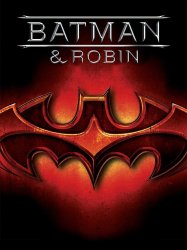
Batman & Robin (1997)
, 2h5Directed by Joel Schumacher
Origin USA
Genres Science fiction, Thriller, Fantastic, Comedy, Fantasy, Action, Adventure, Crime
Themes Films about children, Medical-themed films, Batman films, Superhero films, Films about psychiatry, Super-héros inspiré de comics, Films set in psychiatric hospitals, Eco-terrorism in fiction
Actors Michael Paul Chan, John Glover, Arnold Schwarzenegger, Vivica A. Fox, George Clooney, Chris O'Donnell
Rating38%





Batman and Robin fail to stop Mr. Freeze from stealing a cache of diamonds. They learn that Freeze was once a scientist named Victor Fries, who became dependent on a diamond-powered subzero suit following an accident in a cryogenics lab while working to save his wife, Nora, from a terminal illness called MacGregor's Syndrome.

Batman Forever (1995)
, 2h2Directed by Joel Schumacher
Origin USA
Genres Science fiction, Fantastic, Comedy, Fantasy, Action, Crime
Themes Films about children, Medical-themed films, Batman films, Superhero films, Films about psychiatry, Super-héros inspiré de comics, Films set in psychiatric hospitals
Actors Val Kilmer, Tommy Lee Jones, Jim Carrey, Nicole Kidman, Chris O'Donnell, Michael Gough
Rating54%





In Gotham City, Batman stops a hostage situation in a bank caused by Two-Face, the alter ego of the disfigured former district attorney, Harvey Dent. However, Two-Face escapes. Edward Nygma, a researcher at Wayne Enterprises, develops a device to beam television directly to a person's brain; Bruce Wayne—with whom Nygma is obsessed—rejects the invention, noting that it "raises too many questions", and Nygma angrily resigns from his position after killing his supervisor Fred Stickley, and forging his suicide note and footage. Everybody except Bruce is convinced it was a genuine suicide. During a news report, it shows how Harvey Dent became Two-Face: While he was prosecuting Sal Maroni, Maroni threw acid in Harvey's face; Batman tried to stop him but failed. After meeting Batman-obsessed psychiatrist Dr. Chase Meridian, Bruce invites her to a charity circus event. There, Two-Face and his henchmen storm the event in an attempt to discover Batman's secret identity, and in the process murder The Flying Graysons, a family of acrobats who attempt to stop him. The youngest member, Dick, survives and throws Two-Face's bomb into the river to detonate safely underwater but the rest of the family dies.

Batman: Mask of the Phantasm (1993)
, 1h16Directed by Bruce Timm, Eric Radomski
Origin USA
Genres Drama, Thriller, Action, Adventure, Crime, Animation, Romance
Themes Films about children, Batman films, Ghost films, Superhero films, Super-héros inspiré de comics
Actors Kevin Conroy, Dana Delany, Hart Bochner, Stacy Keach, Abe Vigoda, Mark Hamill
Rating77%





During a conference of crime bosses held in a Gotham City skyscraper, gangster Chuckie Sol is killed by a mysterious cloaked figure, shortly after Batman bursts in on the meeting. Due to the killer's resemblance to Batman, the Dark Knight is blamed for Sol's death. Councilman Arthur Reeves tells the media that Batman is a public menace (despite Commissioner Gordon's protests), then later attends a party at the mansion of billionaire Bruce Wayne, Batman's secret identity. Reeves teases Bruce about his bad luck with women and for having allowed an old girlfriend, Andrea Beaumont, to get away.

Batman Returns (1992)
, 2h6Directed by Tim Burton
Origin USA
Genres Science fiction, Thriller, Fantastic, Fantasy, Action, Crime
Themes Films about animals, Films about children, Christmas films, Films about cats, Batman films, Superhero films, Political films, Super-héros inspiré de comics, Mise en scène d'un mammifère
Actors Michael Keaton, Danny DeVito, Michelle Pfeiffer, Christopher Walken, Michael Gough, Michael Murphy
Rating70%





Tucker and Esther Cobblepot, an aristocratic couple, throw their deformed infant child in a river, feeling that Gotham City's high society would not approve after witnessing their son kill their pet cat. However, a flock of penguins living in an abandoned zoo's arctic exhibit connected to the sewers rescue and raise him. 33 years later, the child becomes The Penguin (Danny DeVito) and the leader of the Red Triangle Circus Gang, who appear in Gotham City during the annual Christmas tree-lighting ceremony and cause a riot. As the police and Batman (Michael Keaton) deal with the riot, one of the guests at the ceremony, a prominent businessman named Max Shreck (Christopher Walken), is kidnapped and taken to the Penguin, who desires to become a citizen of Gotham and blackmails Shreck into helping him by threatening to expose evidence of his corporate crimes.
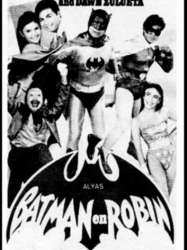
Alias Batman and Robin (1991)
Origin Philippines
Genres Comedy, Action
Themes Films about children, Batman films, Superhero films
Actors Joey de Leon, Keempee de Leon, Vina Morales, Dawn Zulueta, Rene Rabago Requiestas, Panchito Alba
Rating51%






Batman (1989)
, 2h6Directed by Tim Burton
Origin USA
Genres Science fiction, Thriller, Fantasy, Action, Crime
Themes Films about children, Batman films, Superhero films, Super-héros inspiré de comics
Actors Jack Nicholson, Michael Keaton, Kim Basinger, Robert Wuhl, Pat Hingle, Billy Dee Williams
Rating74%





The mayor of Gotham City orders District Attorney Harvey Dent (Billy Dee Williams) and Police Commissioner James Gordon (Pat Hingle) to increase police activity and combat crime in preparation for the city's bicentennial. Reporter Alexander Knox (Robert Wuhl) and photojournalist Vicki Vale (Kim Basinger) begin to investigate reports of a vigilante dubbed "Batman", who is targeting the city's criminals.
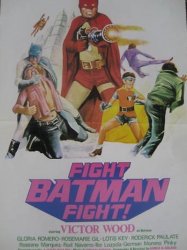
Fight Batman, Fight! (1976)
Origin Philippines
Genres Comedy, Fantasy, Action
Themes Films about children, Batman films, Superhero films
Actors Victor Wood, Roderick Paulate, Gloria Romero, Rosemarie Gil, Romy Diaz, Ike Lozada
Rating63%






Batman Fights Dracula (1967)
Origin Philippines
Genres Comedy, Action, Horror
Themes Films about children, Batman films, Dracula films, Superhero films, Vampires in film
Actors Jing Abalos, Dante Rivero, Ramon d'Salva
Rating66%






Batman (1966)
, 1h45Directed by Leslie H. Martinson
Origin USA
Genres Science fiction, Fantastic, Comedy, Fantasy, Action, Adventure, Crime
Themes Films about children, Batman films, Superhero films, Super-héros inspiré de comics, Children's films
Actors Adam West, Milton Frome, Madge Blake, Burt Ward, Lee Meriwether, Cesar Romero
Rating64%





When Batman (West) and Robin (Ward) get a tip that Commodore Schmidlapp (Reginald Denny) is in danger aboard his yacht, they launch a rescue mission using the batcopter. As Batman descends on the bat-ladder to land on the yacht it suddenly vanishes beneath him. He rises out of the sea with a shark attacking his leg. After Batman dislodges it with bat-shark repellant, the shark explodes. Batman and Robin head back to Commissioner Gordon's office, where they deduce that the tip was a set-up by the United Underworld, a gathering of four of the most powerful villains in Gotham City (Joker, Penguin, Riddler and Catwoman).
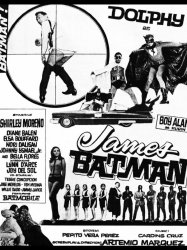
James Batman (1966)
Origin Philippines
Genres Science fiction, Comedy, Action, Adventure
Themes Films about children, Spy films, Films about terrorism, Batman films, Superhero films
Actors Dolphy, Boy Alano, Bella Flores
Rating55%





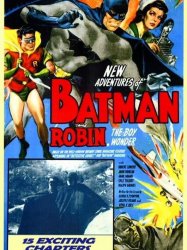
Batman and Robin (1949)
, 4h23Directed by Spencer Gordon Bennet
Origin USA
Genres Science fiction, Thriller, Fantastic, Action, Adventure, Crime
Themes Films about children, Batman films, Superhero films, Super-héros inspiré de comics
Actors Robert Lowery, Johnny Duncan, Poni Adams, Lyle Talbot, Ralph Graves, Don C. Harvey
Rating58%





The Dynamic Duo face off against the Wizard, a hooded villain with an electrical device which controls cars and a desire to set challenges for the Dynamic Duo, whose identity remains a mystery throughout until the end.

Batman (1943)
, 4h20Directed by Lambert Hillyer
Origin USA
Genres Science fiction, War, Thriller, Fantastic, Action, Adventure, Crime
Themes Films about children, Spy films, Politique, Documentary films about war, Documentary films about historical events, Batman films, Superhero films, Zombie films, Political films, Super-héros inspiré de comics, Documentary films about World War II
Actors Lewis Wilson, Douglas Croft, J. Carrol Naish, Shirley Patterson, Knox Manning, William Austin
Rating61%





Batman and Robin struggle against Dr. Daka, a Japanese scientist and agent of Hirohito who has invented a device that turns people into pseudo-zombies and has a base in a funhouse of horrors in a Japanese area of the city. Daka makes several attempts to defeat the Dynamic Duo before finally falling to his death when Robin hits the wrong switch, opening a trapdoor to a pit of crocodiles.
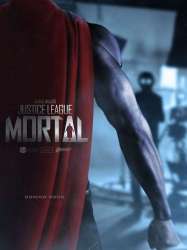
Directed by George Miller
Origin USA
Genres Documentary
Themes Batman films, Superman films, Superhero films, Super-héros inspiré de comics, Films about extraterrestrial life
Actors D. J. Cotrona, Armie Hammer, Megan Gale, Adam Brody, George Miller, Santiago Cabrera
Le documentaire reviendra sur la production secouée du film de Miller.
 Connection
Connection










